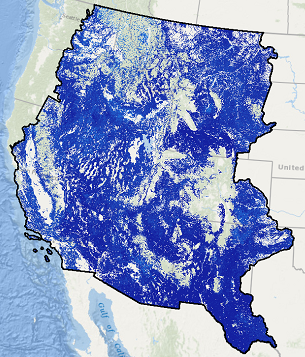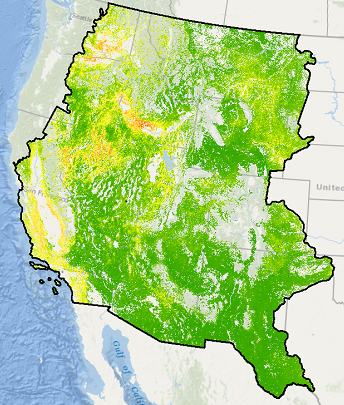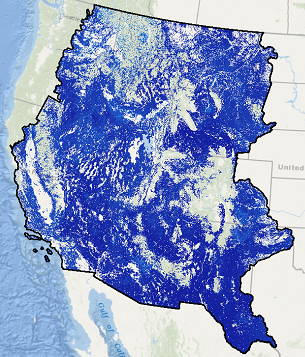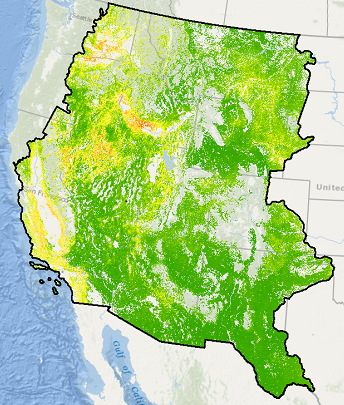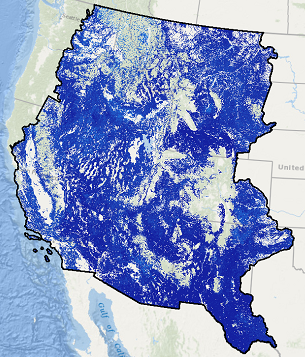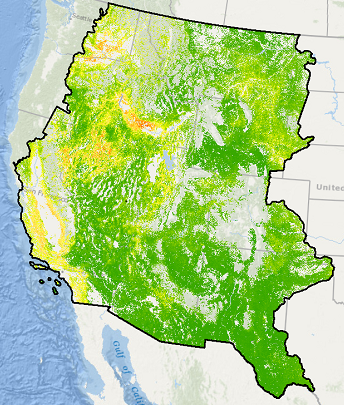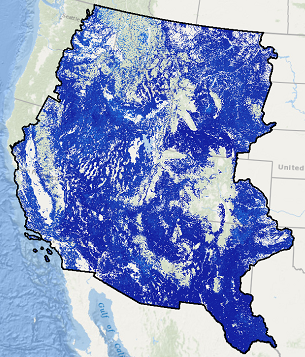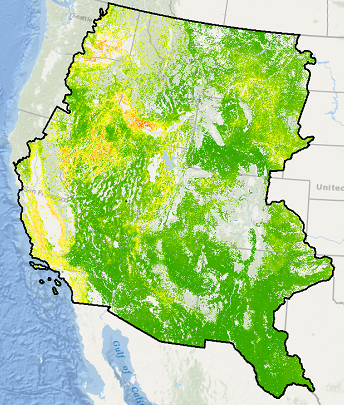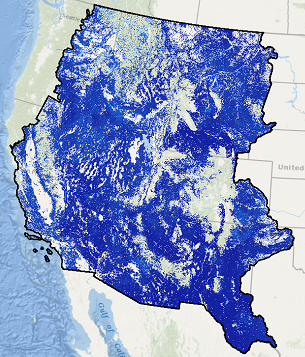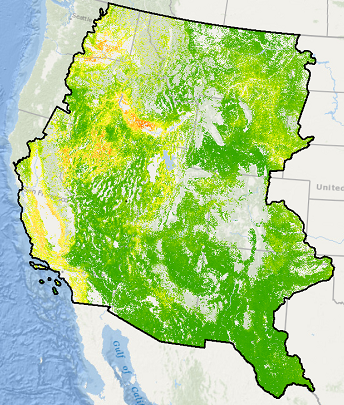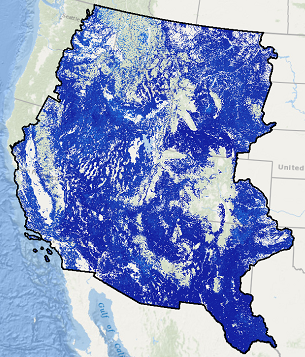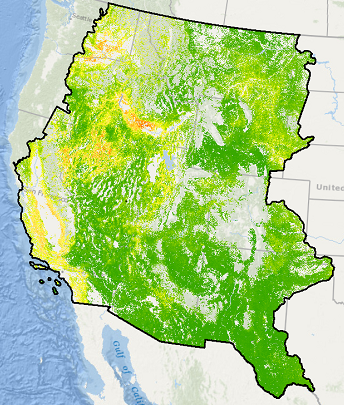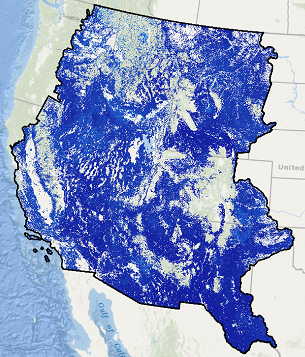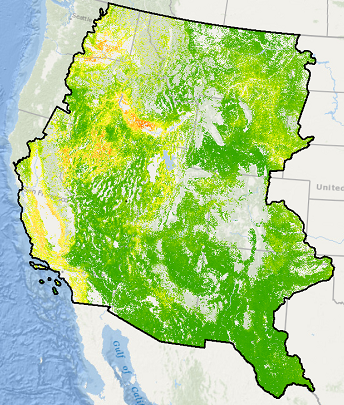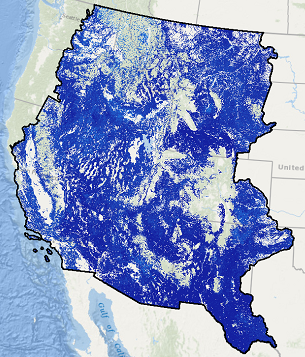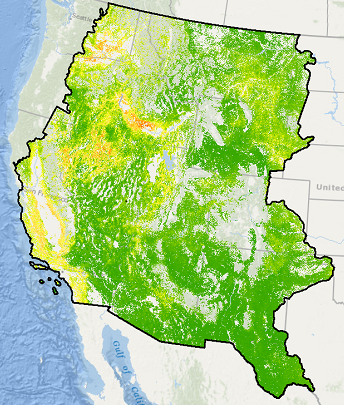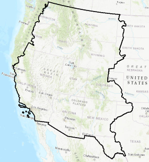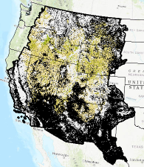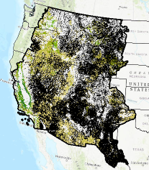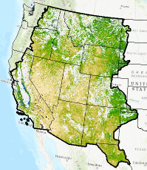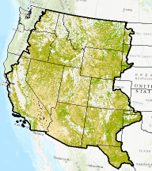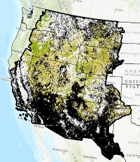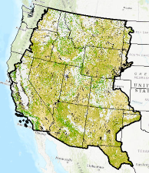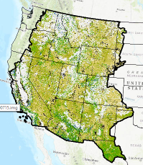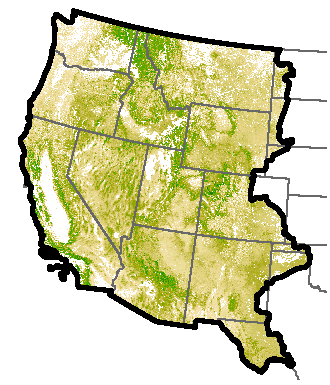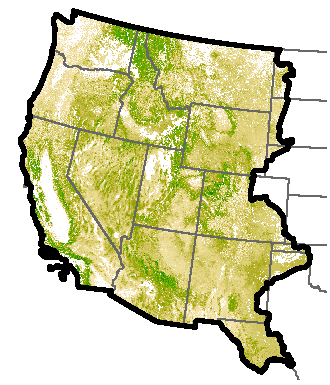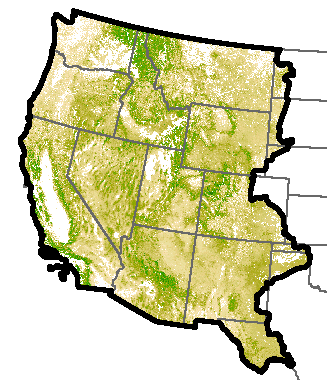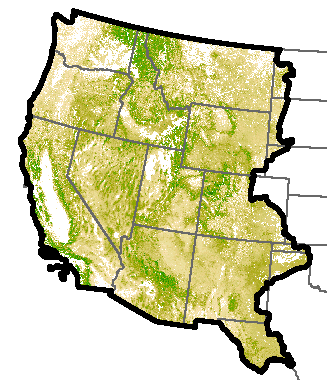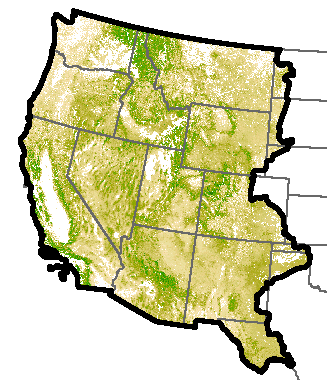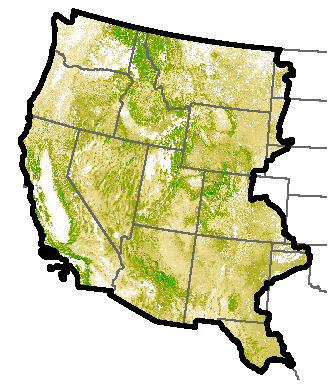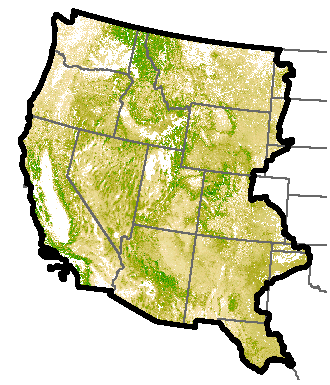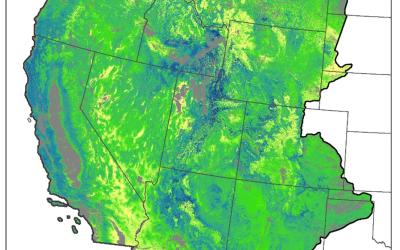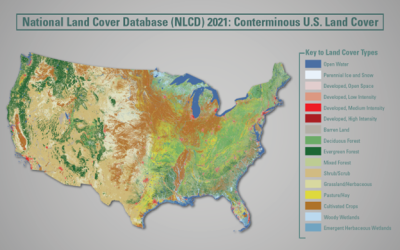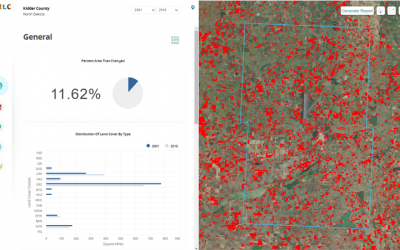Exotic Annual Grass
The Exotic Annual Grass (EAG) abundance dataset provides early season percent cover estimate of the exotic grass species in 30m spatial resolution for a mapped year in rangeland ecosystems of western United States. We plan to release these EAG estimates multiple times each year in early growing season. EAG is a continuous field consisting of abundance of non-native grass species whose life history is complete in one growing season. Cheatgrass (Bromus tectorum) is a dominant species, but this dataset also includes Bromus arvensis L., Bromus briziformis Fisch. & C.A. Mey. Bromus catharticus Vahl, Bromus commutatus Schrad, Bromus diandrus Roth, Bromus hordeaceus L., Bromus hordeaceus spp. Hordeaceus, Bromus japonicus Thunb, Bromus madritensis L., Bromus madritensis L. ssp. rubens (L.) Duvin, Bromus racemosus L., Bromus rubens L., Bromus secalinus L., Bromus texensis (Shear) Hitchc, and medusahead (Taeniatherum caput-medusae (L.) Nevski). A main objective of releasing these maps is to provide a tool for better monitoring EAG dynamics and informing conservation and management efforts at local to regional scales. (Read More)
Exotic Annual Grass Confidence Level June 19th, 2023
Western U.S.
| 2023
Exotic Annual Grass Percent Cover June 19th, 2023
Western U.S.
| 2023
Exotic Annual Grass Confidence Level June 12th, 2023
Western U.S.
| 2023
Exotic Annual Grass Percent Cover June 12th, 2023
Western U.S.
| 2023
Exotic Annual Grass Confidence Level June 5th, 2023
Western U.S.
| 2023
Exotic Annual Grass Percent Cover June 5th, 2023
Western U.S.
| 2023
Exotic Annual Grass Confidence Level May 29th, 2023
Western U.S.
| 2023
Exotic Annual Grass Percent Cover May 29th, 2023
Western U.S.
| 2023
Exotic Annual Grass Confidence Level May 22nd, 2023
Western U.S.
| 2023
Exotic Annual Grass Percent Cover May 22nd, 2023
Western U.S.
| 2023
Exotic Annual Grass Confidence Level May 15th, 2023
Western U.S.
| 2023
Exotic Annual Grass Percent Cover May 15th, 2023
Western U.S.
| 2023
Exotic Annual Grass Confidence Level May 8th, 2023
Western U.S.
| 2023
Exotic Annual Grass Percent Cover May 8th, 2023
Western U.S.
| 2023
Exotic Annual Grass Confidence Level May 1st, 2023
Western U.S.
| 2023
Exotic Annual Grass Percent Cover May 1st, 2023
Western U.S.
| 2023
Exotic Annual Grass Percent Cover - July 01, 2022
Western U.S.
| 2022
Exotic Annual Grass Confidence Level - July 01, 2022
Western U.S.
| 2022
Exotic Annual Grass Percent Cover - June 15, 2022
Western U.S.
| 2022
Exotic Annual Grass Confidence Level - June 15, 2022
Western U.S.
| 2022
Exotic Annual Grass Percent Cover - June 03, 2022
Western U.S.
| 2022
Exotic Annual Grass Confidence Level - June 03, 2022
Western U.S.
| 2022
Exotic Annual Grass Percent Cover - May 18, 2022
Western U.S.
| 2022
Exotic Annual Grass Confidence Level - May 18, 2022
Western U.S.
| 2022
Exotic Annual Grass Percent Cover - May 06, 2022
Western U.S.
| 2022
Exotic Annual Grass Confidence Level - May 06, 2022
Western U.S.
| 2022
Exotic Annual Grass Percent Cover - July 2021
Western U.S.
| 2021
Exotic Annual Grass Confidence Level - July 2021
Western U.S.
| 2021
Exotic Annual Grass Percent Cover - May 2021
Western U.S.
| 2021
Exotic Annual Grass Confidence Level - May 2021
Western U.S.
| 2021
Tree Canopy
NLCD tree canopy cover geospatial datasets with spatial resolutions of 30 m are produced by the USDA Forest Service. Tree canopy cover is derived from multi-spectral satellite imagery and other available ground and ancillary information. Tree canopy products for the period 2011-2021 are available for the conterminous United States, and by summer 2023, they will also cover coastal south east Alaska, Hawaii, Puerto Rico, and U.S. Virgin Islands. (Read More)
NLCD 2021 USFS Tree Canopy Cover (CONUS)
CONUS
| 2021
NLCD 2021 USFS Tree Canopy Cover (HAWAII)
Islands & Territories
| 2021
NLCD 2021 USFS Tree Canopy Cover (ALASKA)
Alaska
| 2021
NLCD 2021 USFS Tree Canopy Cover (PUERTO RICO & U.S. VIRGIN ISLANDS)
Islands & Territories
| 2021
NLCD 2020 USFS Tree Canopy Cover (CONUS)
CONUS
| 2020
NLCD 2020 USFS Tree Canopy Cover (HAWAII)
Islands & Territories
| 2020
NLCD 2020 USFS Tree Canopy Cover (ALASKA)
Alaska
| 2020
NLCD 2020 USFS Tree Canopy Cover (PUERTO RICO & U.S. VIRGIN ISLANDS)
Islands & Territories
| 2020
NLCD 2019 USFS Tree Canopy Cover (CONUS)
CONUS
| 2019
NLCD 2019 USFS Tree Canopy Cover (HAWAII)
Islands & Territories
| 2019
NLCD 2019 USFS Tree Canopy Cover (ALASKA)
Alaska
| 2019
NLCD 2019 USFS Tree Canopy Cover (PUERTO RICO & U.S. VIRGIN ISLANDS)
Islands & Territories
| 2019
NLCD 2018 USFS Tree Canopy Cover (CONUS)
CONUS
| 2018
NLCD 2018 USFS Tree Canopy Cover (HAWAII)
Islands & Territories
| 2018
NLCD 2018 USFS Tree Canopy Cover (ALASKA)
Alaska
| 2018
NLCD 2018 USFS Tree Canopy Cover (PUERTO RICO & U.S. VIRGIN ISLANDS)
Islands & Territories
| 2018
NLCD 2017 USFS Tree Canopy Cover (CONUS)
CONUS
| 2017
NLCD 2017 USFS Tree Canopy Cover (HAWAII)
Islands & Territories
| 2017
NLCD 2017 USFS Tree Canopy Cover (ALASKA)
Alaska
| 2017
NLCD 2017 USFS Tree Canopy Cover (PUERTO RICO & U.S. VIRGIN ISLANDS)
Islands & Territories
| 2017
NLCD 2016 USFS Tree Canopy Cover (ALASKA)
Alaska
| 2016
NLCD 2016 USFS Tree Canopy Cover (HAWAII)
Islands & Territories
| 2016
NLCD 2016 USFS Tree Canopy Cover (PUERTO RICO & U.S. VIRGIN ISLANDS)
Islands & Territories
| 2016
NLCD 2016 USFS Tree Canopy Cover (CONUS)
CONUS
| 2016
NLCD 2015 USFS Tree Canopy Cover (CONUS)
CONUS
| 2015
NLCD 2015 USFS Tree Canopy Cover (HAWAII)
Islands & Territories
| 2015
NLCD 2015 USFS Tree Canopy Cover (ALASKA)
Alaska
| 2015
NLCD 2015 USFS Tree Canopy Cover (PUERTO RICO & U.S. VIRGIN ISLANDS)
Islands & Territories
| 2015
NLCD 2014 USFS Tree Canopy Cover (CONUS)
CONUS
| 2014
NLCD 2014 USFS Tree Canopy Cover (HAWAII)
Islands & Territories
| 2014
NLCD 2014 USFS Tree Canopy Cover (ALASKA)
Alaska
| 2014
NLCD 2014 USFS Tree Canopy Cover (PUERTO RICO & U.S. VIRGIN ISLANDS)
Islands & Territories
| 2014
NLCD 2013 USFS Tree Canopy Cover (CONUS)
CONUS
| 2013
NLCD 2013 USFS Tree Canopy Cover (HAWAII)
Islands & Territories
| 2013
NLCD 2013 USFS Tree Canopy Cover (ALASKA)
Alaska
| 2013
NLCD 2013 USFS Tree Canopy Cover (PUERTO RICO & U.S. VIRGIN ISLANDS)
Islands & Territories
| 2013
NLCD 2012 USFS Tree Canopy Cover (CONUS)
CONUS
| 2012
NLCD 2012 USFS Tree Canopy Cover (HAWAII)
Islands & Territories
| 2012
NLCD 2012 USFS Tree Canopy Cover (ALASKA)
Alaska
| 2012
NLCD 2012 USFS Tree Canopy Cover (PUERTO RICO & U.S. VIRGIN ISLANDS)
Islands & Territories
| 2012
NLCD 2011 USFS Tree Canopy Cover (CONUS)
CONUS
| 2011
NLCD 2011 USFS Tree Canopy Cover (HAWAII)
Islands & Territories
| 2011
NLCD 2011 USFS Tree Canopy Cover (ALASKA)
Alaska
| 2011
NLCD 2011 USFS Tree Canopy Cover (PUERTO RICO & U.S. VIRGIN ISLANDS)
Islands & Territories
| 2011
NLCD ALL USFS Tree Canopy Cover (CONUS)
CONUS
| 2011-2021
RCMAP – Basemap (2016)
RCMAP base component products characterize the percentage of each 30-meter pixel in the Western United States covered by shrub, herbaceous, bare ground, litter, sagebrush, big sagebrush and annual herbaceous, along with estimating shrub height and sagebrush height. These products have been produced by USGS in collaboration with the Bureau of Land Management. Component products are designed to be used individually or combined to support a broad variety of applications.
Please note these new Revised (071520) rangeland products will differ from the first generation of circa 2016 fractional cover maps, a more aggressive masking of tree canopy cover was applied to each rangeland component. Specifically, we have lowered the tree canopy cover threshold for exclusion from 40 to 25%. For pixels with 1-25% tree canopy cover we ensured that our primary components (shrub, herbaceous, litter, and bare ground) cover summed to 100% when added with the tree canopy. And, for the secondary components (sagebrush, big sagebrush, sagebrush height and shrub height) we reconciled to the primary component (shrub), excluding any pinyon-juniper woodlands. (Read More)
NLCD 2016 All Rangeland Cover
Western U.S.
| 2016
NLCD 2016 Bare Ground Rangeland Cover
Western U.S.
| 2016
NLCD 2016 Big Sagebrush Rangeland Cover
Western U.S.
| 2016
NLCD 2016 Annual Herbaceous Rangeland Cover
Western U.S.
| 2016
NLCD 2016 Herbaceous Rangeland Cover
Western U.S.
| 2016
NLCD 2016 Litter Rangeland Cover
Western U.S.
| 2016
NLCD 2016 Sagebrush Rangeland Cover
Western U.S.
| 2016
NLCD 2016 Sagebrush Height Rangeland Cover
Western U.S.
| 2016
NLCD 2016 Shrub Rangeland Cover
Western U.S.
| 2016
NLCD 2016 Shrub Height Rangeland Cover
Western U.S.
| 2016
RCMAP - Future Projections - 2020s, 2050s, and 2080s
RCMAP projected cover products characterize the fractional (i.e., percentage) cover of shrub, herbaceous, bare ground, litter, sagebrush, tree, and annual herbaceous in each 30-meter pixel in the Western United States. Projected data include three time periods (2020s, 2050s, and 2080s) and two climate scenarios (Representative Concentration Pathways [RCP] 4.5 and 8.5). Component cover were harmonized so that the sum of bare ground, shrub, herbaceous, tree, and litter cover adds to ~100% and secondary components sagebrush and annual herbaceous cover were harmonized to their respective primary components of shrub and herbaceous cover, (so their cover could not be greater than their primary component). These products have been produced by USGS in collaboration with the Bureau of Land Management. Component products are designed to be used individually or combined to support a broad variety of applications. Data are packaged by time-period and climate scenarios (six). Additionally, for comparison to reference conditions, a scenario based on 1991-2020 climate normal is available. (Read More)
Rangeland – Future Projections 2080s – rcp 4.5
Western U.S.
| 2080s
Rangeland – Future Projections 2080s – rcp 8.5
Western U.S.
| 2080s
Rangeland – Future Projections 2050s – rcp 4.5
Western U.S.
| 2050s
Rangeland – Future Projections 2050s – rcp 8.5
Western U.S.
| 2050s
Rangeland – Future Projections 2020s – rcp 4.5
Western U.S.
| 2020s
Rangeland – Future Projections 2020s – rcp 8.5
Western U.S.
| 2020s
Rangeland - Backcast 1991-2020
Western U.S.
| 1991-2020

